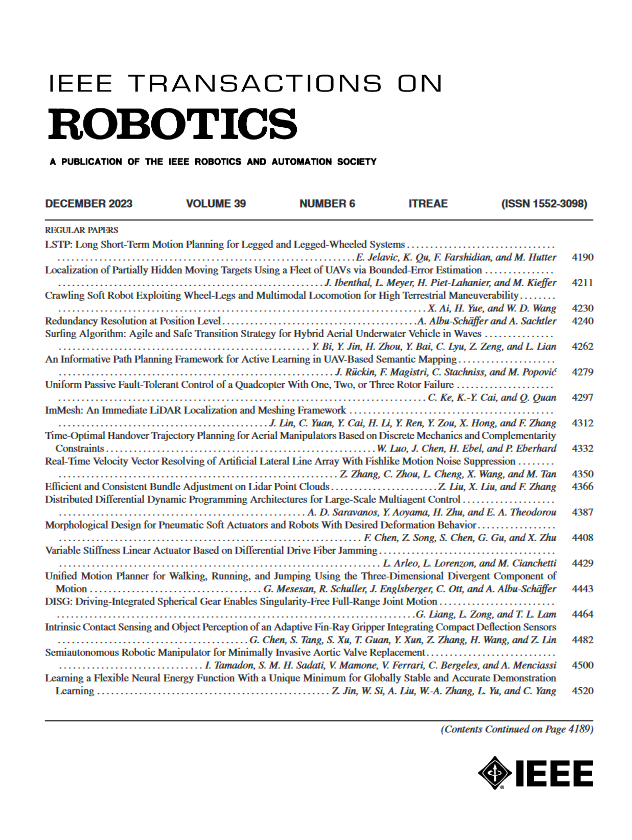Sensor Model Identification via Simultaneous Model Selection and State Variable Determination
IF 10.5
1区 计算机科学
Q1 ROBOTICS
引用次数: 0
Abstract
We present a method for the unattended gray-box identification of sensor models commonly used by localization algorithms in the field of robotics. The objective is to determine the most likely sensor model for a time series of unknown measurement data, given an extendable catalog of predefined sensor models. Sensor model definitions may require states for rigid-body calibrations and dedicated reference frames to replicate a measurement based on the robot’s localization state. A health metric is introduced, which verifies the outcome of the selection process in order to detect false positives and facilitate reliable decision-making. In the second stage, an initial guess for identified calibration states is generated, and the necessity of sensor world reference frames is evaluated. The identified sensor model with its parameter information is then used to parameterize and initialize a state estimation application, thus ensuring a more accurate and robust integration of new sensor elements. This method is helpful for inexperienced users who want to identify the source and type of a measurement, sensor calibrations, or sensor reference frames. It will also be important in the field of modular multiagent scenarios and modularized robotic platforms that are augmented by sensor modalities during runtime. Overall, this work aims to provide a simplified integration of sensor modalities to downstream applications and circumvent common pitfalls in the usage and development of localization approaches.基于模型选择和状态变量确定的传感器模型识别
提出了一种机器人领域定位算法中常用的传感器模型的无人值守灰盒识别方法。目标是在给定预定义传感器模型的可扩展目录的情况下,为未知测量数据的时间序列确定最可能的传感器模型。传感器模型定义可能需要刚体校准的状态和专用参考框架来复制基于机器人定位状态的测量。引入了一个健康度量,它验证选择过程的结果,以检测误报并促进可靠的决策。在第二阶段,对已识别的标定状态进行初始估计,并评估传感器世界参考系的必要性。然后将识别的传感器模型及其参数信息用于参数化和初始化状态估计应用程序,从而确保更准确和鲁棒地集成新的传感器元素。这种方法对于想要确定测量、传感器校准或传感器参考框架的来源和类型的没有经验的用户很有帮助。它在模块化多智能体场景和模块化机器人平台领域也很重要,这些领域在运行期间通过传感器模式进行增强。总的来说,这项工作旨在为下游应用提供传感器模式的简化集成,并规避本地化方法使用和开发中的常见缺陷。
本文章由计算机程序翻译,如有差异,请以英文原文为准。
求助全文
约1分钟内获得全文
求助全文
来源期刊

IEEE Transactions on Robotics
工程技术-机器人学
CiteScore
14.90
自引率
5.10%
发文量
259
审稿时长
6.0 months
期刊介绍:
The IEEE Transactions on Robotics (T-RO) is dedicated to publishing fundamental papers covering all facets of robotics, drawing on interdisciplinary approaches from computer science, control systems, electrical engineering, mathematics, mechanical engineering, and beyond. From industrial applications to service and personal assistants, surgical operations to space, underwater, and remote exploration, robots and intelligent machines play pivotal roles across various domains, including entertainment, safety, search and rescue, military applications, agriculture, and intelligent vehicles.
Special emphasis is placed on intelligent machines and systems designed for unstructured environments, where a significant portion of the environment remains unknown and beyond direct sensing or control.
 求助内容:
求助内容: 应助结果提醒方式:
应助结果提醒方式:


